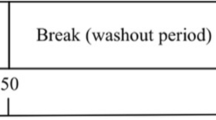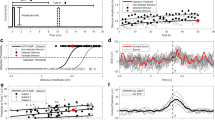Abstract
Background
Among people with idiopathic environmental intolerance attributed to electromagnetic fields (IEI-EMF), a better than random detection ability for a 50-Hz 0.5-mT magnetic field (MF) and a propensity to experience more symptoms than controls was reported in a previous study.
Purpose
The current study aimed to replicate and clarify these results using a modified experimental design.
Method
Participants of the provocation experiment were 49 individuals with self-reported IEI-EMF and 57 controls. They completed the questionnaires (symptom expectations, Somatosensory Amplification Scale—SSAS, radiation subscale of the Modern Health Worries Scale—MHWS Radiation) and attempted to detect the presence of the MF directed to their right arm in 20 subsequent 1-min sessions. Symptom reports were registered after each session.
Results
Individuals with IEI-EMF as opposed to the control group showed a higher than random detection performance (d′ index of signal detection theory), while no difference in their bias (β index) toward the presence of the MF was found. Predictors of reported symptoms were self-reported IEI-EMF and believed as opposed to actual presence of the MF. People with IEI-EMF reported significantly more symptoms particularly in the believed presence of the MF. IEI-EMF was closely related to MHWS Radiation and SSAS scores.
Conclusion
People with IEI-EMF might be able to detect the presence of the MF to a small extent; however, their symptom reports are connected to perceived exposure.

Similar content being viewed by others
References
Petrie KJ, Sivertsen B, Hysing M, Broadbent E, Moss-Morris R, Eriksen HR. Thoroughly modern worries: the relationship of worries about modernity to reported symptoms, health and medical care utilization. J Psychosom Res. 2001;51:395–401.
Bailer J, Bahr V, Stübinger C, Witthöft M. Moderne Gesundheitssorgen und ihre Beziehung zu umweltbezogenen Beschwerden. Z Klin Psychol Psychother. 2008;37:61–9.
Kaptein AA, Helder DI, Kleijn WC, Rief W, Moss-Morris R, Petrie KJ. Modern health worries in medical students. J Psychosom Res. 2005;58:453–7.
Köteles F, Bárány E, Varsányi P, Bárdos G. Are modern health worries associated with somatosensory amplification, environmental attribution style, and commitment to complementary and alternative medicine? Scand J Psychol. 2012;53:144–9.
Spangenberg L, Zenger M, Rief W, Braehler E, Glaesmer H. Assessing modern health worries: dimensionality and factorial invariance across age and sex of the Modern Health Worries Scale in a general population sample. J Health Psychol. 2013;1359105313488980.
ICNIRP. Guidelines for limiting exposure to time-varying electric and magnetic fields (1Hz-100kHz). Health Phys. 2010;99:818–36.
Leitgeb N. Comparative health risk assessment of electromagnetic fields. Wien Med Wochenschr. 2011;161:251–62.
WHO. Fact Sheet No. 296: Electromagnetic fields and public health [Internet]. World Health Organization; 2005. Source: http://www.emfandhealth.com/WHO_EMSensitivity.pdf
Röösli M. Radiofrequency electromagnetic field exposure and non-specific symptoms of ill health: a systematic review. Environ Res. 2008;107:277–87.
Rubin GJ, Nieto-Hernandez R, Wessely S. Idiopathic environmental intolerance attributed to electromagnetic fields (formerly ‘electromagnetic hypersensitivity’): an updated systematic review of provocation studies. Bioelectromagnetics. 2010;31:1–11.
Rubin GJ, Das Munshi J, Wessely S. Electromagnetic hypersensitivity: a systematic review of provocation studies. Psychosom Med. 2005;67:224–32.
Seitz H, Stinner D, Eikmann T, Herr C, Röösli M. Electromagnetic hypersensitivity (EHS) and subjective health complaints associated with electromagnetic fields of mobile phone communication—a literature review published between 2000 and 2004. Sci Total Environ. 2005;349:45–55.
Witthöft M, Rubin GJ. Are media warnings about the adverse health effects of modern life self-fulfilling? An experimental study on idiopathic environmental intolerance attributed to electromagnetic fields (IEI-EMF). J Psychosom Res. 2013;74:206–12.
Frick U, Kharraz A, Hauser S, Wiegand R, Rehm J, von Kovatsits U. Comparison perception of singular transcranial magnetic stimuli by subjectively electrosensitive subjects and general population controls. Bioelectromagnetics. 2005;26:287–98.
Landgrebe M, Frick U, Hauser S, Langguth B, Rosner R, Hajak G. Cognitive and neurobiological alterations in electromagnetic hypersensitive patients: results of a case-control study. Psychol Med. 2008;38:1781–91.
Rubin GJ, Hahn G, Everitt BS, Cleare AJ, Wessely S. Are some people sensitive to mobile phone signals? Within participants double blind randomised provocation study. BMJ. 2006;332:886–91.
Szemerszky R, Köteles F, Lihi R, Bárdos G. Polluted places or polluted minds? An experimental sham-exposure study on background psychological factors of symptom formation in ‘Idiophatic Environmental Intolerance attributed to electromagnetic fields’. Int J Hyg Environ Health. 2010;213:387–94.
Frick U, Rehm J, Eichhammer P. Risk perception, somatization, and self report of complaints related to electromagnetic fields—a randomized survey study. Int J Hyg Environ Health. 2002;205:353–60.
Köteles F, Szemerszky R, Gubányi M, Körmendi J, Szekrényesi C, Lloyd R. Idiopathic environmental intolerance attributed to electromagnetic fields (IEI-EMF) and electrosensibility (ES) – are they connected? Int J Hyg Environ Health. 2013;216:362–70.
Rubin GJ, Cleare AJ, Wessely S. Psychological factors associated with self-reported sensitivity to mobile phones. J Psychosom Res. 2008;64:1–9. discussion 11–2.
Oftedal G, Vistnes AI, Rygge K. Skin symptoms after the reduction of electric fields from visual display units. Scand J Work Environ Health. 1995;21:335–44.
Rea WJ, Pan Y, Fenyves EJ, Sujisawa I, Samadi N, Ross GH. Electromagnetic field sensitivity. J Biol. 1991;10:241–56.
Zwamborn APM, Vossen S, van Leersum B, Ouwens M, Makel W. Effects of global communication system radio-frequency on well being and cognitive functions of human subjects with and without subjective symptoms. The Hague: Netherlands Organisation for Applied Scientific Research (TNO); 2003.
Göthe CJ, Molin C, Nilsson CG. The environmental somatization syndrome. Psychosomatics. 1995;36:1–11.
Staudenmayer H, Binkley KE, Leznoff A, Phillips S. Idiopathic environmental intolerance: part 2: a causation analysis applying Bradford Hill’s criteria to the psychogenic theory. Toxicol Rev. 2003;22:247–61.
Leitgeb N, Schröttner J. Electrosensibility and electromagnetic hypersensitivity. Bioelectromagnetics. 2003;24:387–94.
Köteles F, Szemerszky R, Freyler A, Bárdos G. Somatosensory amplification as a possible source of subjective symptoms behind modern health worries. Scand J Psychol. 2011;52:174–8.
Barsky AJ, Wyshak G, Klerman GL. The Somatosensory Amplification Scale and its relationship to hypochondriasis. J Psy Res. 1990;24:323–34.
Köteles F, Gémes H, Papp G, Túróczi P, Pásztor A, Freyler A. A Szomatoszenzoros Amplifikáció Skála (SSAS) magyar változatának validálása. Mentálhigiéné és Pszichoszomatika. 2009;10:321–35.
Preece AW, Kaune W, Grainger P, Preece S, Golding J. Magnetic fields from domestic appliances in the UK. Phys Med Biol. 1997;42:67.
NIEHS. Questions and answers about EMF electric and magnetic fields associated with the use of electric power (DOE/EE-0040). Washington DC: National Institute of Environmental Health Sciences; 1995.
MacMillan NA, Creelman CD. Detection theory: a user’s guide. 2nd ed. Mahwah: Lawrence Erlbaum Associates; 2005.
Barsky AJ, Saintfort R, Rogers MP, Borus JF. Nonspecific medication side effects and the nocebo phenomenon. JAMA. 2002;287:622–7.
Barsky AJ, Rogers MP. When are medication side effects due to the nocebo phenomenon? — reply. JAMA. 2002;287:2502–4.
Köteles F, Bárdos G. What makes us sicker? An experimental study of non-specific adverse drug effects. Clin Exp Med J. 2011;5:203–15.
Röösli M, Hug K. Wireless communication fields and non-specific symptoms of ill health: a literature review. Wien Med Wochenschr. 2011;161:240–50.
ICNIRP. Exposure to static and low frequency electromagnetic fields, biological effects and health consequences (0-100 kHz). München: International Commission on Non-Ionizing Radiation Protection; 2003.
Kirschvink JL, Kobayashi-Kirschvink A, Diaz-Ricci JC, Kirschvink SJ. Magnetite in human tissues: a mechanism for the biological effects of weak ELF magnetic fields. Bioelectromagnetics. 1992;Suppl 1:101–13.
WHO. Extremely low frequency fields. Environmental Health Criteria [Internet]. Geneva: World Health Organization; 2007. Source: http://www.who.int/peh-emf/publications/Complet_DEC_2007.pdf
Köteles F, Simor P. Modern health worries, somatosensory amplification and subjective symptoms: a longitudinal study. Int J Behav Med. 2013;20:38–41.
Bailer J, Witthöft M, Rist F. Modern health worries and idiopathic environmental intolerance. J Psychosom Res. 2008;65:425–33.
Köteles F, Simor P. Modern health worries, somatosensory amplification, health anxiety, and well-being. A cross-sectional Study. Eur J Mental Health. 2014;9:20–33.
Acknowledgments
This research was supported by the Hungarian National Scientific Research Fund (OTKA K 76880, K 109549) and by the János Bolyai Research Scholarship of the Hungarian Academy of Sciences. The authors would like to thank Prof. Wolfgang Schwartz for his help and valuable comments on signal detection calculations and György Thuróczy for his comments on the exact description of the physical characteristics of the experimental equipment.
Conflict of Interest
All authors declare that they do not have any conflict of interest.
Ethical Statement
The authors state that all procedures followed were in accordance with the ethical standards of the responsible committee on human experimentation (institutional and national) and with the Helsinki Declaration of 1975, as revised in 2000. Informed consent was obtained from all patients for being included in the study.
Author information
Authors and Affiliations
Corresponding author
Rights and permissions
About this article
Cite this article
Szemerszky, R., Gubányi, M., Árvai, D. et al. Is There a Connection Between Electrosensitivity and Electrosensibility? A Replication Study. Int.J. Behav. Med. 22, 755–763 (2015). https://doi.org/10.1007/s12529-015-9477-z
Published:
Issue Date:
DOI: https://doi.org/10.1007/s12529-015-9477-z




